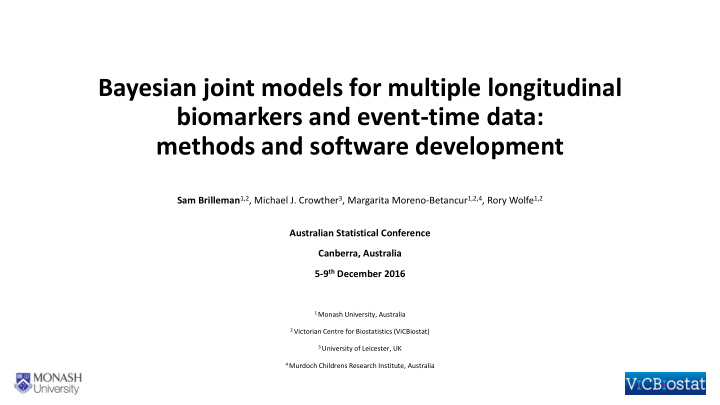



Bayesian joint models for multiple longitudinal biomarkers and event-time data: methods and software development Sam Brilleman 1,2 , Michael J. Crowther 3 , Margarita Moreno-Betancur 1,2,4 , Rory Wolfe 1,2 Australian Statistical Conference Canberra, Australia 5-9 th December 2016 1 Monash University, Australia 2 Victorian Centre for Biostatistics (ViCBiostat) 3 University of Leicester, UK 4 Murdoch Childrens Research Institute, Australia
Background What is joint modelling? • The joint estimation of distinct regression models which, traditionally, we would have estimated separately • One or more longitudinal (mixed effects) models • each for a repeatedly measured clinical marker, e.g. systolic blood pressure • A survival or time-to-event (proportional hazards) model • for the time to an event, e.g. time-to-death, time-to-stroke
Background Why use joint modelling? • We want to know whether the longitudinal marker is associated with the risk of the event • e.g. how is time-varying SBP associated with the risk of death? • can actually consider association between the event risk and any aspect of the longitudinal trajectory (e.g. slope) • can allow for measurement error in the marker • can allow for discrete-time measurement of the marker • And possibly other reasons… • e.g. dynamic predictions, separating out “direct” and “indirect” effects of treatment, adjusting for informative dropout
𝑧 𝑗𝑙 𝑢 is the value at time 𝑢 of the 𝑙 th longitudinal marker ( 𝑙 = 1, … , 𝐿 ) Joint model specification for the 𝑗 th individual ( 𝑗 = 1, … , 𝑂 ) 𝑈 𝑗 is “true” event time, 𝐷 𝑗 is the censoring time ∗ = min 𝑈 𝑗 , 𝐷 𝑗 𝑈 𝑗 and 𝑒 𝑗 = 𝐽(𝑈 𝑗 ≤ 𝐷 𝑗 ) Longitudinal submodel 𝑧 𝑗𝑙 𝑢 follows a distribution in the exponential family with expected value 𝜈 𝑗𝑙 𝑢 and ′ ′ 𝜃 𝑗𝑙 𝑢 = 𝑙 𝜈 𝑗𝑙 𝑢 = 𝒚 𝒋𝒍 𝑢 𝜸 𝒍 + 𝒜 𝒋𝒍 𝑢 𝒄 𝒋𝒍 𝒄 𝒋𝟐 ⋮ = 𝒄 𝒋 ~ 𝑂 0, 𝚻 𝒄 𝒋𝑳 Event submodel 𝐿 𝑅 𝑙 ′ 𝑢 𝜹 + ℎ 𝑗 (𝑢) = ℎ 0 (𝑢) exp 𝒙 𝒋 𝛽 𝑙𝑟 𝑔 𝑙𝑟 (𝜃 𝑗𝑙 𝑢 , 𝜈 𝑗𝑙 𝑢 , 𝜸 𝑙 , 𝒄 𝒋𝒍 ) 𝑙=1 𝑟=1
𝑧 𝑗𝑙 𝑢 is the value at time 𝑢 of the 𝑙 th longitudinal marker ( 𝑙 = 1, … , 𝐿 ) Association structures for the 𝑗 th individual ( 𝑗 = 1, … , 𝑂 ) 𝑈 𝑗 is “true” event time, 𝐷 𝑗 is the censoring time ∗ = min 𝑈 𝑗 , 𝐷 𝑗 𝑈 𝑗 and 𝑒 𝑗 = 𝐽(𝑈 𝑗 ≤ 𝐷 𝑗 ) Longitudinal submodel 𝑧 𝑗𝑙 𝑢 follows a distribution in the exponential family with expected value 𝜈 𝑗𝑙 𝑢 and ′ ′ 𝜃 𝑗𝑙 𝑢 = 𝑙 𝜈 𝑗𝑙 𝑢 = 𝒚 𝒋𝒍 𝑢 𝜸 𝒍 + 𝒜 𝒋𝒍 𝑢 𝒄 𝒋𝒍 𝒄 𝒋𝟐 ⋮ = 𝒄 𝒋 ~ 𝑂 0, 𝚻 𝒄 𝒋𝑳 Event submodel 𝐿 𝑅 𝑙 ′ 𝑢 𝜹 + ℎ 𝑗 (𝑢) = ℎ 0 (𝑢) exp 𝒙 𝒋 𝛽 𝑙𝑟 𝑔 𝑙𝑟 (𝜃 𝑗𝑙 𝑢 , 𝜈 𝑗𝑙 𝑢 , 𝜸 𝑙 , 𝒄 𝒋𝒍 ) 𝑙=1 𝑟=1
Association structures 𝑔 𝑙𝑟 𝜃 𝑗𝑙 𝑢 , 𝜈 𝑗𝑙 𝑢 , 𝜸 𝒍 , 𝒄 𝒋𝒍 = ? 𝜃 𝑗𝑙 𝑢 Value of the linear predictor at time 𝑢 𝜈 𝑗𝑙 𝑢 Expected value of the marker at time 𝑢 𝑒𝜈 𝑗𝑙 𝑢 Rate of change in the marker (i.e. slope) at time 𝑢 𝑒𝑢 𝑢 Area under the marker trajectory (e.g. cumulative dose) up to time 𝑢 න 𝜈 𝑗𝑙 𝑡 𝑒𝑡 0
Joint model likelihood Likelihood function: 𝐿 𝑜 𝑗𝑙 ∞ 𝑞 𝒛 𝒋𝟐 , … , 𝒛 𝒋𝑳 , 𝑈 𝑗 , 𝑒 𝑗 𝒄 𝒋 , 𝜾) = න ෑ ෑ 𝑞 𝑧 𝑗𝑙 𝑢 𝑗𝑘𝑙 𝒄 𝒋 , 𝜾 𝒛 𝒍 𝑞 𝑈 𝑗 , 𝑒 𝑗 𝒄 𝒋 , 𝜾 𝑼 ) 𝑞 𝒄 𝒋 𝜾 𝒄 d𝒄 𝒋 −∞ 𝑙=1 𝑘=1 event random effects k th longitudinal submodel model submodel • Assumes conditional independence , that is, conditional on 𝒄 𝒋 the distinct longitudinal and event processes are independent • requires we specify the model correctly, including the “association structure” • Time-dependence in the event likelihood poses an additional computational burden
Bayesian joint models via Stan RStanJM RStanArm Stan RStan R package R package C++ library R interface for for for for Bayesian Joint Bayesian Applied full Bayesian Stan Modelling Regression inference Modelling (MCMC)
Bayesian joint models via Stan Currently separate packages, but soon to be merged RStanJM RStanArm Stan RStan R package R package C++ library R interface for for for for Bayesian Joint Bayesian Applied full Bayesian Stan Modelling Regression inference Modelling (MCMC)
Bayesian joint models via Stan • Development version currently available as a stand- alone package ‘ rstanjm ’ • https://github.com/sambrilleman/rstanjm • Association structures • current value or slope (of linear predictor or mean) • shared random effects (optionally including fixed effect component) • Variety of prior distributions • Regression coefficients: normal, student t, Cauchy, and horseshoe (shrinkage) priors • Novel decomposition of covariance matrix for the random effects • Variety of link functions and error distributions • Incl. normal, binomial, Poisson, negative binomial, gamma • Baseline hazard • Weibull, piecewise constant, or B-splines approximation
Example • Data: Mayo Clinic’s primary biliary cirrhosis (“PBC”) data • Longitudinal submodels: • Outcomes: log serum bilirubin, albumin • Linear mixed model w/ random intercept and random linear slope • Event submodel • Time-fixed covariate: gender • Association structure: current value and slope (bilirubin), current value (albumin) • Weibull baseline hazard
Can easily change priors or baseline hazard
Thank you • My PhD supervisors: Rory Wolfe, Margarita Moreno-Betancur, Michael Crowther, John Carlin • My PhD funders: NHMRC and Victorian Centre for Biostatistics (ViCBiostat) • Staff from ViCBiostat • Ben Goodrich and Jonah Gabry (authors of RStanArm)
Recommend
More recommend